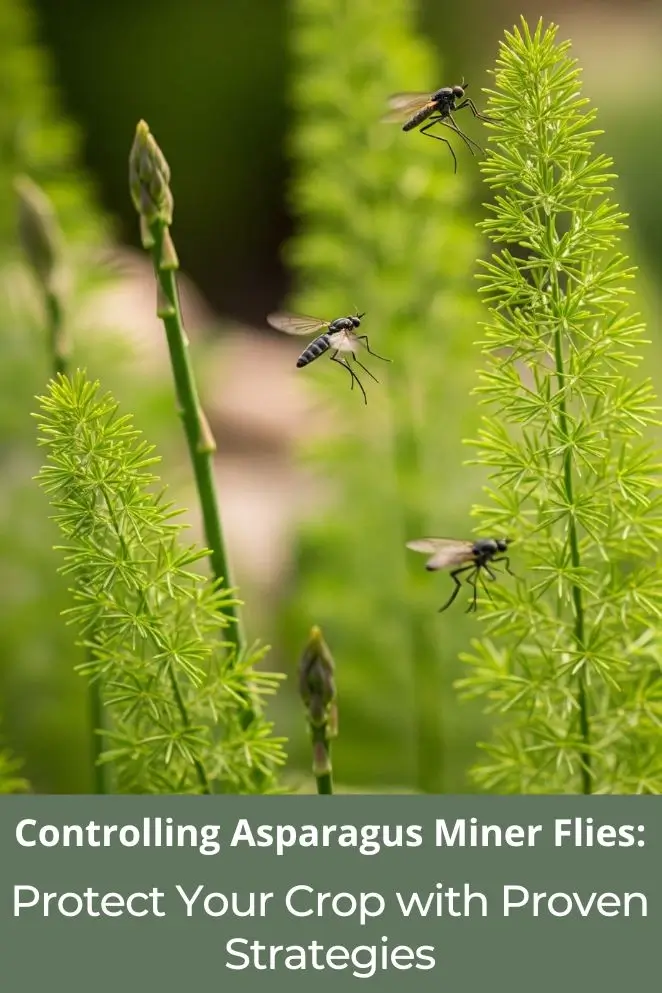
Asparagus growers face a ton of headaches, but the asparagus miner fly (Ophiomyia simplex) is like the ultimate troublemaker.
Tiny as it is, this insect can wreck your plants, mess up your harvest, and even spread nasty fungal diseases that wipe out whole patches.
I’ve seen gardens that looked fine one week turn into disaster zones the next, all thanks to these little pests.
Understanding the Asparagus Miner Fly Threat
What are asparagus miner flies?
Asparagus miner flies (Ophiomyia simplex) are tiny but specialized pests that only attack asparagus.
They came over from Europe and now pop up pretty much anywhere asparagus grows.
The adults are small, dark flies that lay eggs inside the stalks.
When the larvae hatch, they tunnel through the stems, leaving telltale “mines” that weaken the plant and open the door for fungal diseases.
What makes them extra nasty is that they can spread Fusarium, a fungus tied to asparagus decline all over the world.
Life cycle and damage patterns
Timing matters here: adults show up in early summer, drop their eggs into asparagus stems, and the larvae chew tunnels several inches long.
That chewing not only weakens stalks but also creates perfect openings for Fusarium crown and root rot (FCRR) — one of the deadliest threats to asparagus crops.
That’s why controlling these flies isn’t just pest management, it’s disease prevention.
Integrated Pest Management Strategies
Cultural control methods
The first line of defense is good habits in the garden.
Miner flies love messy asparagus patches, so clean-up is key.
That means chopping down and removing stalks at season’s end, destroying any wild asparagus within a couple football fields of your crop, and properly burning or burying infested plants.
Think of it like not leaving snacks out for pests.
Choosing Fusarium-resistant varieties is another smart move—it’s like giving your plants armor.
You can even trick flies by letting a few spears grow into ferns early, then yanking them once flies lay eggs there instead of on your main crop.
Biological control options
Here’s where nature lends a hand.
Tiny parasitic wasps love to lay their eggs inside miner fly pupae (brutal but effective).
You can help these allies by planting flowers nearby, avoiding “nuke-everything” pesticides, and giving them safe spots to overwinter.
Scientists are even experimenting with scents that literally lure the wasps straight to the asparagus patch—kind of like setting up a wasp buffet.
Chemical control strategies
Sometimes, though, you need backup. Growers often use pesticides like Sevin, but timing is everything.
Spray too early or too late, and it’s a waste.
The sweet spot is early summer, right before flies start laying eggs.
Always spray during calm weather and focus on older ferns, damaged spots, field edges, and wild asparagus that’s acting like a bug hotel.
Monitoring and decision-making
None of this works if you’re flying blind.
You’ve got to scout weekly, looking for those telltale mining tunnels and checking sticky traps for adults.
Keep track of degree-days (basically bug calendars based on temperature) to time sprays right.
And always weigh the cost: if damage is minor, it might not be worth the chemicals.
But if miner flies are hitting hard, acting fast can save both this year’s harvest and next year’s plants.
Advanced Management Techniques
Precision agriculture applications
Modern tech lets you fight asparagus miner flies like a pro gamer using high-level gear.
GPS-guided sprayers and spot-treatments mean you only hit the problem areas — saves money and keeps the rest of the field chill.
Drones are especially sick for scouting: they map the field fast so you can see where the bugs are clustered, which zones actually need treatment, where beneficial insects are doing their thing, and which patches of soil or plants are acting sus and inviting pests.
Drone mapping helps find:
- Areas of heaviest infestation
- Zones that need immediate treatment
- Locations where biological control is already working
- Field variations that raise pest pressure
Integrated disease management
Miner flies don’t just munch plants — they open the door for nasty diseases.
So you can’t just fight the fly and call it a day.
A smart program pairs insect control with disease tactics: time fungicide use to match miner activity, build soil health so pathogens can’t dominate, pick Fusarium-resistant varieties, and rotate crops where that’s possible.
Think of it like a double-defense plan — stop the invader and strengthen the fortress.
Sustainable intensification
Balancing yield and the planet means using every tool thoughtfully.
Integrated Pest Management (IPM) is the playbook: mix biological control, habitat tweaks, smarter cultural practices, and resistant varieties, and only bring in pesticides when monitoring shows they’re truly needed.
This keeps:
- Pesticide resistance from evolving
- Beneficial insects safe and working for you
- Soil and water healthier long-term
- Production sustainable year after year
Do it right and you’re not just saving this season’s harvest — you’re investing in the farm’s future.
Implementation Guidelines for Growers
Season-long management calendar
Early spring (March–April)
This is clean-up and prep season. Get rid of last year’s asparagus “skeletons” (overwintering debris) — miner flies love hiding out in that mess.
Pick your plant varieties like you’re drafting a fantasy football team (resistant ones are your MVPs).
Check that your monitoring tools actually work (calibrate those traps, don’t just trust them fresh out of the box).
If you’re going to bring in backup like biological control agents, now’s the time to order them.
Late spring (May–June)
Game time. Start scouting every week — yes, like an annoying school project, but it pays off big.
Put out sticky traps to catch the early wave of adult flies (kind of like bug Tinder, except they don’t swipe, they stick).
Hunt down and destroy any wild asparagus nearby — they’re basically pest Airbnb’s.
Oh, and make sure your spray gear is ready before the pests show up, not after.
Summer (July–August)
This is when the miner flies try to flex.
Track degree-days (fancy science way of saying “watch how much heat time they’ve had to develop”) so you know when they’ll pop.
Only treat if the economic threshold says it’s worth it — don’t waste money or chemicals.
Keep tabs on whether your beneficial bugs are actually putting in work. And always write down whether treatments worked — future-you will thank you.
Fall (September–October)
Clean up again — think of it like hitting “reset” on the field so the pests don’t get free housing over winter.
Review the season: what worked, what flopped, what needs tweaking. Order resistant varieties now before the good ones sell out.
Economic considerations
Here’s the reality check: controlling asparagus miner flies costs money, but ignoring them costs more.
You’ve got direct yield losses (ugly spears nobody wants to buy), hidden losses from diseases they spread, plus whatever you spend on sprays, labor, and gear.
Long-term, miner damage can shorten the life of your whole planting.
But here’s the kicker: premium, clean asparagus fetches better prices, so investing in control can literally pay for itself.
Record keeping and evaluation
Write. Stuff. Down. Seriously. Track how bad the pest pressure was, when you treated, if it worked, what the weather was like, and how it affected your yield and sales.
It feels like busywork, but it’s basically your personal cheat sheet for next year.
Good records turn guesswork into strategy.
Conclusion
Beating the asparagus miner fly isn’t about one magic spray — it’s about playing the long game.
You need a full toolkit: clean fields, destroy wild asparagus hangouts, let good bugs do their thing, and only use chemicals when the timing is just right.
Think of it like fighting a boss in a video game: you don’t rush in with all your ammo, you learn its patterns first.



